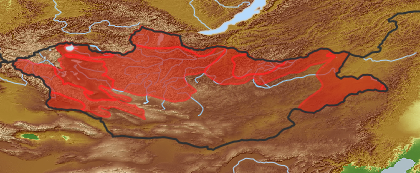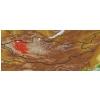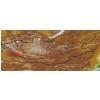| Class: | angiosperms |
| Order: | Lamiales |
| Family: | Callitrichaceae |
| Genus: | Callitriche |
| Scientific name: | Callitriche palustris L. |
| Name acc. to: | Gubanov 1996 |
| Herbar: | list records    |
| Description: | Plants amphibious or semisubmerged in water. Leaves spatulate, narrowing toward base, light green, nontransparent, with well developed stomata, 3 veins. Fruits narrow winged, at least at the top, 0.8-1.2 mm long. |
| Comments: | Widely distributed aquatic plant. In the Flora of China the species is divided in 3 varieties based on characters of the small, 4-lobed fruits. |
| Link to Flora of China: | http://www.efloras.org/browse.aspx?flora_id=2&name_str=Callitriche+palustris |
| open map in a new window |  |
| Habitat: | Backwaters, old river beds, channels, small lakes, bogs, damp pebbles, muddy river banks and lake coasts (Grubov 2001). |
| Habit (i)general appearance of a plant | |
| Parasite status: (i)Is the plant a half- or full parasite? | no parasite/saprophyte (i)Plant fully autonomous, leaves with chlorophyll
example: Most plants, Ranunculus  inherited by family Callitrichaceae: no parasite/saprophyte inherited by family Callitrichaceae: no parasite/saprophyte
|
| Water or terrestrial plant: (i)Where do the plants grow? | water or swamp plant  inherited by family Callitrichaceae: water or swamp plant inherited by family Callitrichaceae: water or swamp plant
|
| Leaf (i)expanded, usually photosynthetic organ of a plant (including phylloclades) | |
| Leaf veination: (i)Arrangement of the main veins of a leaf. | pinnate (i)One main vein, several side veins, sometimes inconspicuous
example: Cicerbita     inherited by family Callitrichaceae: pinnate inherited by family Callitrichaceae: pinnate
|
| Flower (i)reproductive portion of the plant, consisting of sepals, petals, stamens, and pistils | |
| Flower appearance and pollination: (i)General appearance of the flower. | not attractive, wind-pollinated or some water plants (i)Small, colourless or green flowers
example: Betula, grasslike plants: Carex, Setaria, Juncus  inherited by family Callitrichaceae: not attractive, wind-pollinated or some water plants inherited by family Callitrichaceae: not attractive, wind-pollinated or some water plants
|
| Perianth arrangement: (i)Attention: in some plants, flowers may be dimorphic in different ways (dioecious or gynodioecious). If flowers vary, record the characters of the most showy flowers. | absent or strongly reduced (i)No perianth leaves ensheathing stamen and/or carpels
example: Callitriche   inherited by genus Callitriche: absent or strongly reduced inherited by genus Callitriche: absent or strongly reduced
|
| Spur: (i)A hollow, slender, sac-like appendage of the perianth leaves, storing nectar. | no spur (i)Flower without appendage
example: Peganum  inherited by family Callitrichaceae: no spur inherited by family Callitrichaceae: no spur
|
| Root / shoot below ground (i)plant part below ground (in most cases), including below ground shoots, without leaves | |
| Root type: (i)Organisation of the roots. | allorhizous (i)Plant with a conspicuous tap root, one larger tap root with side roots
example: Dicotyledonae  inherited by order Lamiales: allorhizous inherited by order Lamiales: allorhizous
|
| Distribution (i)region where the plant is likely to be found | |
| Distribution (Veg. Zones): (i)acc. to Grubov 1952 | Khubsgul (i)In distribution data often named as '1' 
Khentei (i)In distribution data often named as '2' 
Khangai (i)In distribution data often named as '3' 
Mongol-Daurian (i)In distribution data often named as '4' 
Great Khingan (i)In distribution data often named as '5' 
Mongolian Altai (i)In distribution data often named as '7' 
East Mongolia (i)In distribution data often named as '9' 
Depression of Great Lakes (i)In distribution data often named as '10' 
Dzungarian Gobi (i)In distribution data often named as '14' 
acc. to: Gubanov 1996 |
| Distribution Khangay: (i)acc. Flora Khangaya 1989 | III
IV
V
|